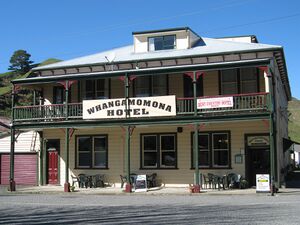Republic of Whangamomona
This article may require cleanup to meet MicroWiki's quality standards. |
Republic of Whangamomona | |
|---|---|
| Capital | Whangamomona 39°8′37″S 174°44′13″E |
| Demonym(s) | Whangamomonan |
| Government | Presidential democratic republic |
• President of the Republic | John Herlihy |
| Independence from New Zealand | |
• Republic formed | 1 November 1989 |
| Area | |
• Total | 689.60 km2 (266.26 sq mi) |
| Population | |
• 2018 census | 126 |
• Density | 0.18271461716937354/km2 (0.5/sq mi) |
The Republic of Whangamomona also known as Whangamomona is a New Zealand based micronation. Whangamomona is located in the Stratford District of the Taranaki Region of New Zealand's North Island (Te Ika-a-Māui)[1]. It is New Zealand's oldest known micronation with is founding on 1 November 1989.
Unlike other micronations in New Zealand, the Republic of Whangamomona, holds its independence as a means of a tourist icon and has never set up any official government in any capacity and it is believed by other observers in the micronational community that no such government will ever come about.
Name
The name Whangamomona comes from a town located in New Zealand.
History
The first European settlers arrived in 1895, with the town proper established some 2 years later. Growth of the town was seriously affected by the loss of 51 men (including the smaller nearby settlements of Kohuratahi and Tahora) in the First World War and a major flood in 1924. The town recovered with arrival of the railway line in 1933 and electrification in 1959. However the town went into decline again and the school closed in 1979, followed nine years later by the post office.
In 1989, regional council boundaries were redrawn, with an emphasis on connected catchments. These revised maps made Whangamōmona part of the then-Manawatu-Wanganui Region since the Whangamōmona River is a tributary of the Whanganui River. Residents objected, as they wanted to continue being part of the Taranaki Region, and on 1 November 1989, they responded by declaring themselves the "Republic of Whangamomona" at the first Republic Day. Though the move began as a pointed protest, the town continued to hold a celebratory Republic Day once a year, during which a vote for President was held. The day has become a local festival day, and attracts visitors from throughout the North Island. In 2001, the celebration became biennial, held in January to take advantage of the summer weather.

In July 2020, the name of the locality was officially gazetted as Whangamōmona by the New Zealand Geographic Board.[2]
Presidents
Ian Kjestrup (1989–1999)
After being put on the ballot without his knowledge, Kjestrup became the first elected President, serving 10 years.
Billy Gumboot the Goat (1999–2001)
Gumboot was the first elected animal. He won election by a landslide, although some residents speculate he ate the other challengers' ballots in order to win. He died in office after serving for 18 months.
Tai the Poodle (2003–2004)
Tai retired after he was attacked by a mastiff, but some speculate it was an assassination attempt. Though he survived the attack, Tai was left unfit for service and died in 2010.
Sir Murt "Murtle the Turtle" Kennard (2005–2015)
The local garage owner fought off strong competition from former President Kjestrup to become the 4th President. He was re-elected in 2009 by one vote, and again by a landslide in 2011. Kennard died at New Plymouth Hospice on 25 October 2015.
Vicki Pratt (2015–2017)

Pratt was the first female President appointed for the Whangamomona Republic.
John Herlihy (2017–present)
Herlihy was elected ahead of Jack Spearow, Lili Jiao (who wanted to be a cat) and Ted (who was already a cat), despite reported attempts by Spearow to steal ballots. On Republic Day 2019 (19 January) President Herlihy was re-elected for a second term, having fought off challenges from Maketoni the Teddy Bear, Sherman the Cockatoo, Eunice the Sheep, Griff Robb (who proposed that the land-locked nation should enter into maritime tourism) and a Mrs Brown look-alike at the polls. Controversy surrounded the election due to the disappearance of candidate Eunice the Sheep, with commentators noting that mutton sandwiches were for sale at the Republic Day barbecue.
